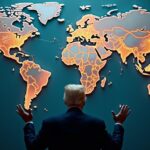Pharma manufacturing is decentralising fast. Discover six strategies manufacturers can use to ride the new wave of globalisation and stay ahead of competitors.
Global pharma is not just growing. It is accelerating and spreading out.
The global pharmaceutical market is estimated at more than 1.6 trillion USD in 2024 and is projected to reach over 2.3 trillion USD by 2030. Within that, contract manufacturing and research services are already a market of more than 260 billion USD, expected to approach 400 billion USD by 2030.
At the same time, governments and companies are actively reshaping supply chains. Studies show that a large majority of organisations are diversifying their supplier base and investing in regional or friendshoring strategies to reduce risk. For pharma, this means buyers are actively looking beyond their traditional supplier lists and exploring new manufacturing partners across Asia, Europe, Latin America, Africa and the Middle East.
In simple terms:
Demand is global, risk is local, and supply is decentralising.
Pharma manufacturers who understand this shift early can turn it into a competitive advantage. Those who wait may find that global projects and strategic partnerships have already been captured by others.
Below are six practical ways manufacturers can ride this globalisation wave with confidence.
1. Treat compliance as your global language
In a world of distributed supply, compliance is often the first filter. Buyers in regulated and semi regulated markets assess manufacturers based not only on capacity and price, but on visible signals of quality and reliability. These include:
- Certifications aligned with USFDA, EU GMP, WHO GMP or other recognised frameworks
- Strong audit track record and preparedness
- Complete and well structured technical documentation
- Clear explanation of quality systems, data integrity and validation practices
Many countries are also pushing policies that support more geographically diverse supply chains to avoid over dependence on a single region. Manufacturers that present a robust and transparent compliance profile are better placed to benefit from such policy trends.
You do not need to over claim. What matters is clarity and credibility. Make sure your certifications, audit history and quality processes are easy to understand and easy to verify.
2. Invest in flexible and modular manufacturing capacity
Global demand today is more dynamic than ever. Buyers may start with small batches for a few markets and then quickly ramp up, or they may need niche technologies on relatively short timelines.
Manufacturers who invest in flexible infrastructure are better positioned to respond. Examples include:
- Multi product facilities that can switch across APIs, intermediates or formulations
- Containment systems that allow handling of higher potency molecules
- Modular production lines that can be reconfigured with minimal downtime
- Capacity planning that keeps some headroom for strategic or high value projects
The global pharmaceutical manufacturing market itself is projected to grow significantly this decade, driven by outsourcing, advanced therapies and complex products. Buyers will naturally gravitate towards partners who can scale with them, rather than those who are always operating at full capacity with limited flexibility.
3. Focus on long term partnerships, not one time transactions
Globalisation in pharma is no longer just about shipping product across borders. It is increasingly about building cross border ecosystems.
Manufacturers can gain more from this shift by positioning themselves as long term partners rather than transactional suppliers. Some practical approaches include:
- Co development arrangements with formulation or biotech companies
- Backward integration partnerships for KSMs and intermediates
- Joint ventures or alliances in specific markets
- Multi year supply agreements with defined improvement roadmaps
Such models help both sides. Buyers gain stability and shared risk. Manufacturers gain predictable volume, better planning, and deeper integration into their partners portfolios and pipelines.
In a decentralising world, the depth of your relationships can matter more than the number of RFQs you receive.
4. Increase transparency of capabilities and capacity
A surprising number of capable manufacturers are under utilised globally because buyers cannot clearly understand what they can do. To ride the globalisation wave, your capabilities must be visible and unambiguous. Key elements to communicate include:
- Product and service portfolio with clear technical detail
- Site wise regulatory status and inspection history
- Installed and available capacity, including dosage forms or reaction capabilities
- Market reach and export experience
- Safety, EHS and sustainability practices
- Special technologies such as HPAPI, controlled release, sterile lines or biologics related capacity
The goal is to help a sourcing manager or CDMO scout quickly answer three questions:
- Can this manufacturer technically do what we need,
- Is the quality profile aligned with our markets, and
- Is the scale suitable.
If any of these answers is unclear, the buyer often moves on to a more transparent alternative, even if that option is not technically superior.
5. Enter emerging regions early, before they mature
Globalisation is no longer only about the United States, Europe and Japan. Some of the fastest growing opportunities lie in emerging regions such as:
- Africa, which is increasingly prioritising local or regional manufacturing for essential medicines and vaccines
- The Middle East, which is investing heavily in life sciences and high value formulations
- Southeast Asia, which is becoming a key base for APIs, intermediates and contract services
- Latin America, where demand for branded generics, OTC products and localised manufacturing continues to rise
Manufacturers can approach these markets in stages:
- Start with export driven supply from existing facilities
- Develop regulatory familiarity with agencies such as SAHPRA, ANVISA or GCC regulators
- Build local partnerships for distribution, packaging or secondary manufacturing
- Evaluate local or regional facilities once volumes justify it
The common pattern across many industries is simple. The first serious, high quality entrants to a region often build relationships that are hard to displace later.
6. Use digital platforms to plug into global deal flow
The most underused lever for many manufacturers today is digital visibility. Global buyers and sourcing teams now rely on a mix of channels: traditional networks, conferences, direct outreach and increasingly, digital platforms that help them map the global manufacturing landscape faster.
Specialised digital platforms for pharma sourcing allow buyers to:
- Search by capability, dosage form, geography and compliance status
- Compare multiple manufacturers in a structured way
- Initiate confidential discussions with pre screened partners
- Discover suppliers they might never meet through physical events alone
Platforms such as Pharmalinkage, for instance, are designed to connect manufacturers with buyers who are actively looking for API, formulation, CDMO or contract manufacturing partners worldwide. The value for a manufacturer is not aggressive selling, but simple, credible presence in a place where global sourcing teams are already searching.
In an environment where contract manufacturing, research and services are growing strongly as a segment, being discoverable on the right digital platforms is becoming just as important as attending the right trade fair.
Conclusion: The wave is here, the question is timing
Globalisation in pharma is evolving from a model of a few dominant hubs to a more distributed, risk balanced and digitally connected ecosystem.
- The market is large and growing.
- Demand for contract manufacturing and services is expanding.
- Governments and companies are actively working to diversify supply chains.
For manufacturers, the opportunity is real, but it is not infinite. Those who act now to strengthen compliance signalling, invest in flexible capacity, build long term partnerships, communicate transparently, enter emerging regions early and leverage digital platforms will be better placed to ride this wave.
The globalisation wave is already building height. The practical question for every manufacturer is simple: Do you start paddling now, or do you wait until your competitors are already surfing it?
Pharma Manufacturing
Pharma Manufacturing
Comments are closed.










